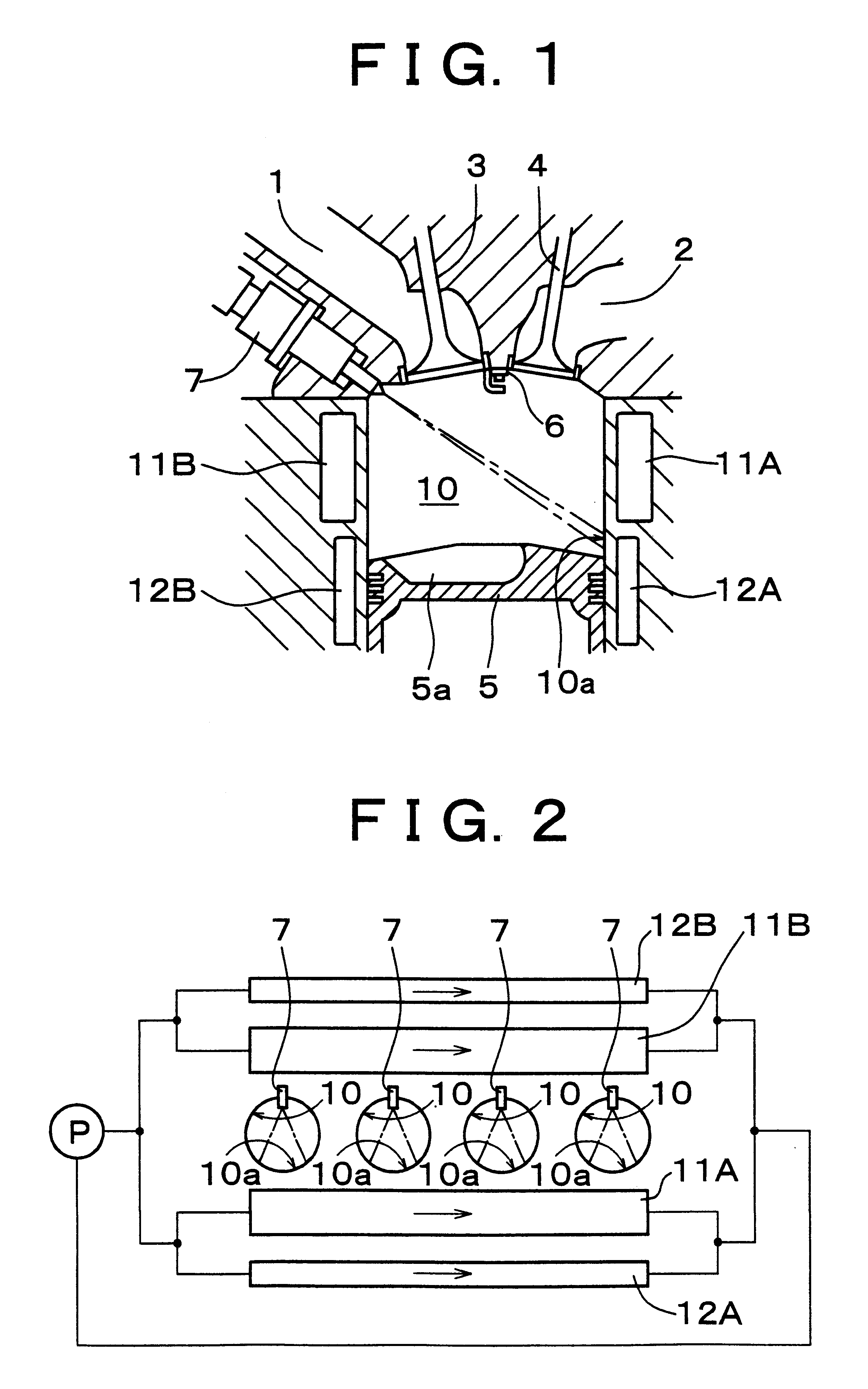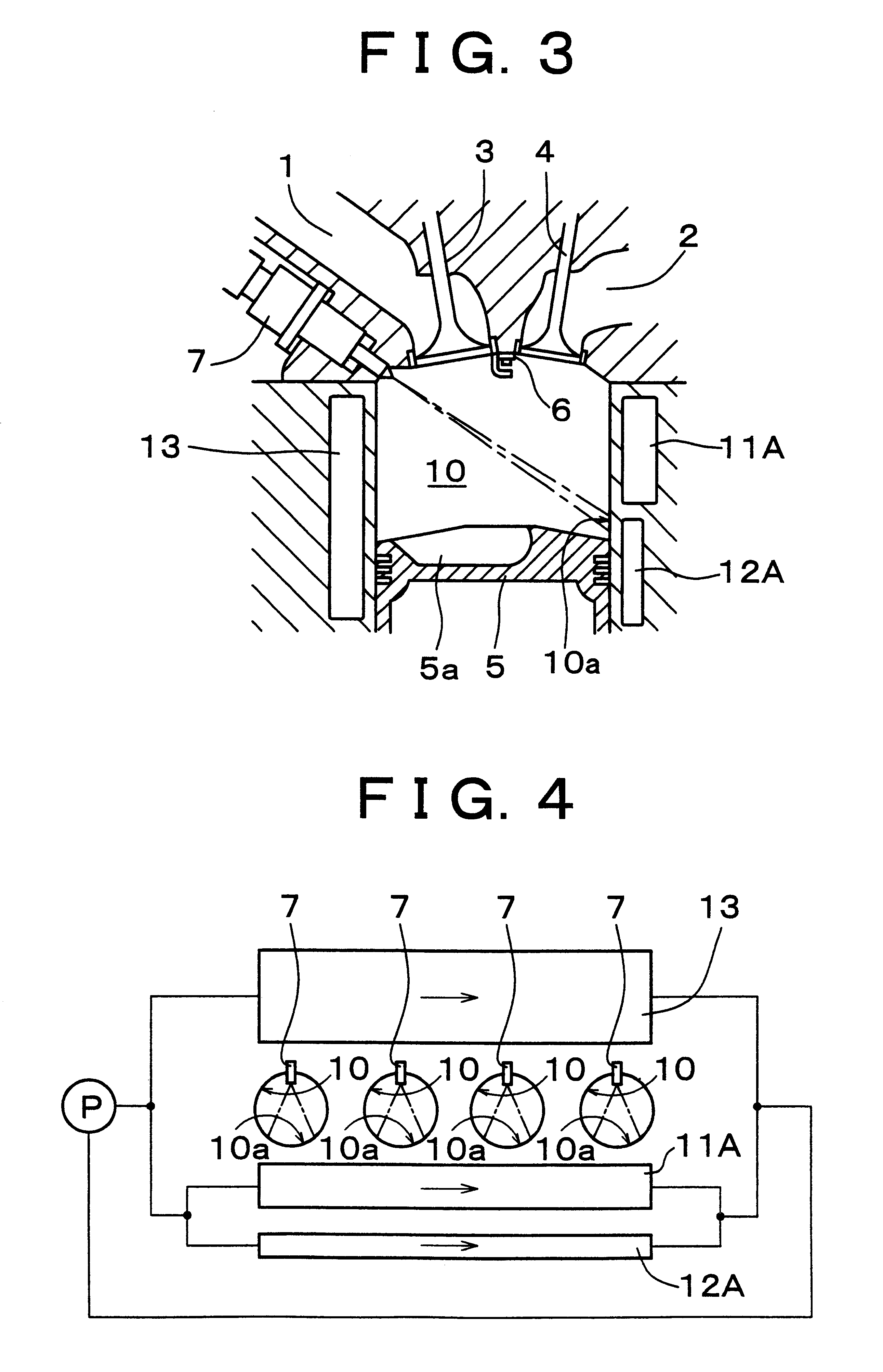Direct-fuel-injection-type spark-ignition internal combustion engine and method of controlling the internal combustion engine
a technology of internal combustion engine and fuel injection type, which is applied in the direction of electric control, machines/engines, mechanical equipment, etc., can solve the problems of deteriorating fuel consumption rate, insufficient cooling of the upper section of the cylinder bore on the side opposed to the nozzle hole of the fuel injection valve, and inability to inject a large amount of fuel in the latter half of the compression strok
- Summary
- Abstract
- Description
- Claims
- Application Information
AI Technical Summary
Benefits of technology
Problems solved by technology
Method used
Image
Examples
first embodiment
FIG. 1 schematically shows a longitudinal section of a direct-fuel-injection-type spark-ignition internal combustion engine in accordance with the present invention. In FIG. 1, an intake port 1 and an exhaust port 2 are disposed in an upper section of a cylinder. The intake port 1 leads to the cylinder through an intake valve 3, and the exhaust port 2 leads to the cylinder through an exhaust valve 4. A piston 5 is disposed in the cylinder, and a recessed cavity 5a is formed in a top face of the piston 5. An ignition plug 6 is disposed substantially at the center of an upper section of a combustion chamber. A fuel injection valve 7 for directly injecting fuel into the cylinder from the periphery of the upper section of the cylinder is disposed to circumvent the intake port 1 and the exhaust port 2. To avoid vaporization of fuel, the fuel injection valve 7 is disposed on the side of the intake valve which is at a relatively low temperature due to the flow of intake air. The fuel injec...
fifth embodiment
Thus, if an exhaust passage is formed in the neighborhood of the lower section of the cylinder bore 10 on the side opposed to the nozzle hole of the fuel injection valve, the impingement portion 10a opposed to the nozzle hole of the fuel injection valve in the lower section of the cylinder bore 10 can be heated by exhaust gas that has just been discharged from the cylinder and that is at a high temperature. Thus, the impingement portion 10a opposed to the nozzle hole of the fuel injection valve further rises in temperature and becomes capable of gasifying adherent fuel almost instantaneously. As a result, the fifth embodiment can more reliably solve the problems of deterioration of fuel consumption rate and dilution of engine oil.
fourth embodiment
The exhaust passage 15 may be designed as part of a main exhaust passage of the engine through which exhaust gas flows constantly. However, in this embodiment, the exhaust passage 15 is designed as a branch exhaust passage which branches off from a main exhaust passage 16 through a control valve 17, as can be seen from FIG. 10. At the time of stratified charge combustion, which does not require heating of the impingement portion 10a opposed to the nozzle hole of the fuel injection valve in the cylinder bore 10, the control valve 17 is closed so that exhaust gas does not flow through the branch exhaust passage 15. Thus, at the time of stratified charge combustion, the impingement portion 10a opposed to the nozzle hole of the fuel injection valve in the cylinder bore 10 is maintained at almost the same temperature as in the fourth embodiment wherein the adiabatic layer is formed.
As described above, regardless of whether stratified charge combustion or homogeneous combustion is carried...
PUM
 Login to View More
Login to View More Abstract
Description
Claims
Application Information
 Login to View More
Login to View More - R&D
- Intellectual Property
- Life Sciences
- Materials
- Tech Scout
- Unparalleled Data Quality
- Higher Quality Content
- 60% Fewer Hallucinations
Browse by: Latest US Patents, China's latest patents, Technical Efficacy Thesaurus, Application Domain, Technology Topic, Popular Technical Reports.
© 2025 PatSnap. All rights reserved.Legal|Privacy policy|Modern Slavery Act Transparency Statement|Sitemap|About US| Contact US: help@patsnap.com



